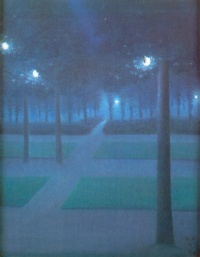Belgian Symbolism
From The Art and Popular Culture Encyclopedia
|
"Belgium was the focus of symbolism, where the work of Félicien Rops, Fernand Khnopff and William Degouve de Nuncques is noted. The first was a painter and graphic artist of great imagination, with a predilection for a theme centered on perversity and eroticism. Khnopff developed a dreamlike-allegorical theme of women transformed into angels or sphinxes, with disturbing atmospheres of great technical refinement. Degouve de Nuncques elaborated urban landscapes with a preference for nocturnal settings, with a dreamlike component precursor of surrealism: his work The Blind House (1892, Kröller-Müller Museum, Otterlo) influenced René Magritte's The Empire of Lights (1954, Musées Royaux des Beaux-Arts de Belgique, Brussels)."--Sholem Stein |

|
Related e |
|
Featured: |
Symbolism was a European movement, with emphasis on France and Belgium. The Belgian representatives included Jean Delville, William Degouve de Nuncques, Léon Spilliaert, Khnopff and the journalist Albert Mockel.
Literature
- Emile Verhaeren (1855–1916)
- Albert Giraud (1860–1929)
- Maurice Maeterlinck (1862–1949)
- Albert Mockel (1866–1945)
Painting
- Félicien Rops (1855–1898)
- Fernand Khnopff (1858–1921)
- Henry de Groux (1866 - 1930)
- Jean Delville (1867–1953)
- Léon Spilliaert (1882–1946)

